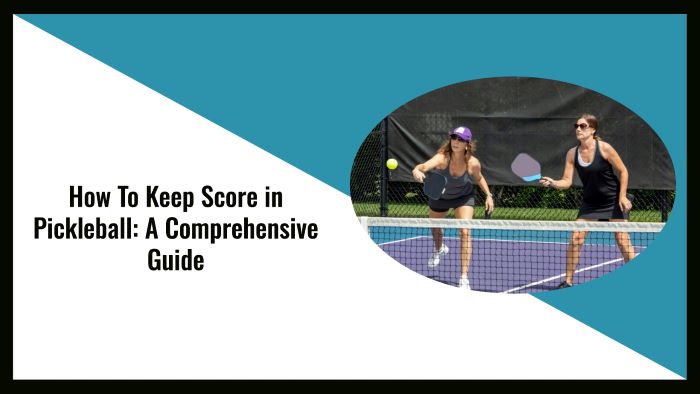Welcome to the exciting world of pickleball! This fast-paced and engaging sport has gained widespread popularity in recent years, drawing players of all ages and skill levels to the courts. If you’re new to pickleball, one essential skill to master is keeping score.

While it may seem daunting at first, understanding how to keep score in pickleball is crucial to playing the game and enjoying it to the fullest. In this article, we will provide a comprehensive guide on how to keep score in pickleball, from basic rules to advanced scoring techniques.
So, whether you’re a beginner or an experienced player looking to brush up on your scoring skills, read on to become a pickleball scorekeeping pro!
The Basic Rules of Scoring in Pickleball
Scoring in pickleball is fairly simple, but there are some nuances that can make it tricky at times. Here are some basic rules to remember:
- Only the serving team can score points.
- The serving team switches service courts after each point until they commit a fault and lose the serve.
- The first serve of each game is made from the right-hand service court by one player of the serving team. This player continues to serve until they commit a fault.
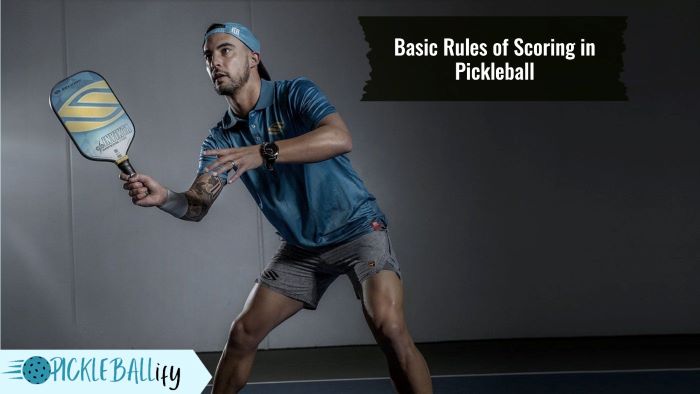
- After the first fault, the serve passes to their partner, who serves from the left-hand service court. This player continues to serve until they commit a fault.
- After both players of the serving team have served and committed faults, the serve passes to the receiving team.
- The receiving team becomes the new serving team and follows the same pattern: one player serves from the right-hand service court until they commit a fault, then their partner serves from the left-hand service court until they commit a fault.
- This cycle repeats until one team reaches 11 points and wins by two points.
The Basics of Serving and Scoring in Pickleball
Serving and scoring in pickleball are different from other racquet sports, such as tennis or badminton. Here are some basic rules and strategies to remember when serving and scoring in pickleball:
- Only one serve is allowed per player per turn unless it is a let serve (the ball touches the net and lands in play).
- Only the serving team can score points. The receiving team can only win back the serve by winning a rally.
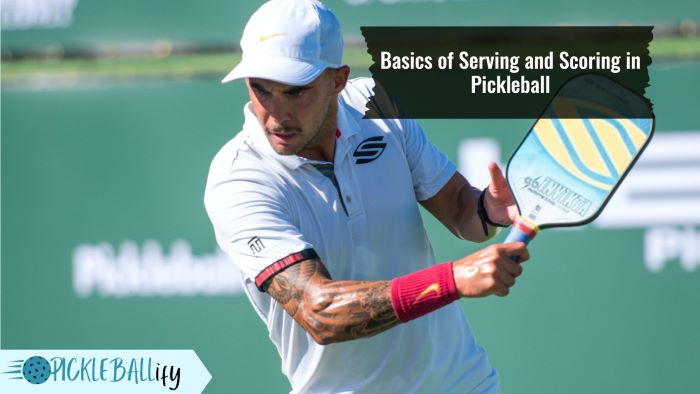
- The score is announced before each serve by saying three numbers: the server’s score, the receiver’s score, and the server number (1 or 2). For example, if you are serving at 5-3-2, it means you have 5 points, your opponents have 3 points and you are the second server on your team.
- The first server of each side starts from the right service area at 0-0-2. This means that they only get one chance to serve before switching to their partner. This way, both teams have an equal number of serves at the start of each game.
- After each side out (when both servers on a team lose their serves), the first server of the next team starts from the right service area at 0-0-2. This means that they only get one chance to serve before switching to their partner. This way, both teams have an equal number of serves at the start of each game.
How to Keep Track of the Score and Call it Out
Keeping track of the score and calling it out correctly is another essential skill in pickleball, as it helps avoid confusion and disputes among players. Here are some guidelines on how to keep track of the score and call it out properly:
- The serving team’s score, the receiving team’s score, and the server’s number make up the final score (1 or 2). For instance, if the first server is serving and the serving team has 5 points, the receiving team has 3, and the score is 5-3-1.
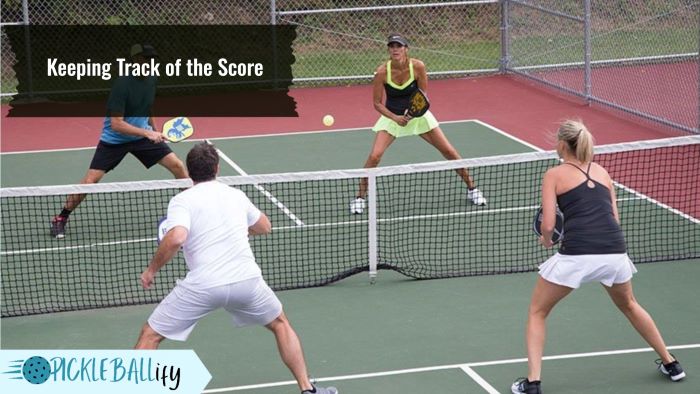
- Before each serve, the server must announce the score clearly and loudly. After calling the score, the server should additionally state their number (1 or 2). For instance, the server should announce, “Five-three-one, I’m one,” if the score is 5-3-1.
- The receiver should confirm the result by saying it aloud to the server or by nodding. The players should pause the game and resolve any scoring disputes or ambiguities before continuing.
- The players should use a flip card or paddle as a scoring tool, or they can keep the score mentally. It’s important for the players to keep track of who is serving and which service court they are in.
How Scoring Works in Pickleball Singles
In singles pickleball, there are only two numbers in the score: 1) the server’s score and 2) the receiver’s score. The server’s score is always announced first, followed by the receiver’s score. For example, if the server has 6 points and the receiver has 3 points, then the server must say “6-3” before serving.
You can also check out the visual presentation on Pickleball score rules Here.
The other difference in singles pickleball is that there is only one serve per side. This means that if the server commits a fault or loses a rally, it will lose its serve and become the receiver. Then, the new server will start from either service area depending on their score.
The same rule applies for singles pickleball as for doubles pickleball: the server must serve from the right service area if their score is even, and from the left service area if their score is odd. This ensures that the serve goes crosscourt to the opposite service area of the receiver.
Common Scoring Mistakes and How to Avoid Them
Pickleball scoring can be tricky at times, especially when you are new to the game or playing with unfamiliar partners or opponents. Here are some common scoring mistakes that you may encounter on the pickleball court and how to correct them:
1) Forgetting or mixing up your own score or your opponent’s score: This can happen when you are distracted by other things or lose track of who won which point. To avoid this mistake, try to keep track of every point in your head or use a scoring device such as a paddle tap or a flip card.
Also, make sure you listen carefully to your opponent’s score announcement before each serve and confirm it with them if you are unsure.
2) Forgetting or mixing up your server number: This can happen when you switch sides with your partner after winning a point or when you lose track of who served first or second. To avoid this mistake, try to remember who served first at the start of each game and who served second.
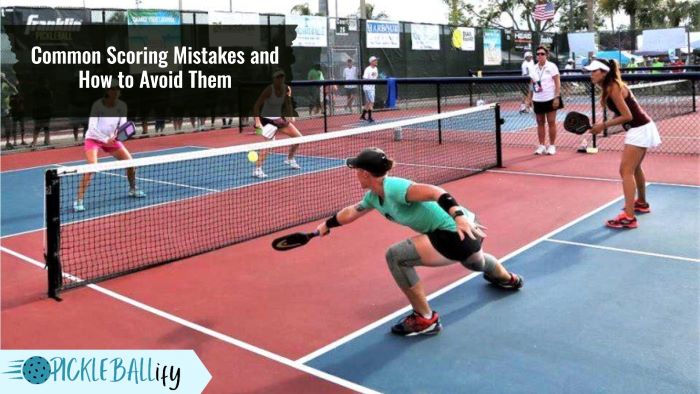
3) Forgetting or mixing up your serving position: This can happen when you lose track of your own score or your opponent’s score, or when you switch sides with your partner after a point. To avoid this mistake, try to remember which side of the court corresponds to your score being even or odd.
Also, make sure you look at the centerline before each serve and align yourself with the correct service area.
4) Calling out the wrong score or not calling out the score at all: This can happen when you are not paying attention to the score or when you are not confident in your scoring skills. To avoid this mistake, try to practice calling out the score before each service and gets feedback from your partner or opponents if you are correct.
Also, make sure you respect the etiquette of pickleball and call out the score loud and clear for everyone to hear.
Tips and Tricks to Improve Your Pickleball Skills
The serve is one of the most important shots in pickleball, as it sets up the tone and pace of the rally. A good serve can give you an advantage over your opponents and help you win more points.
Here are some tips and tricks to improve your pickleball serve and make it more effective:
- Aim for depth and accuracy: Your opponents will be forced back and find it more challenging to make a return if you serve deep and it falls close to the baseline. It will also limit your opponents’ choices and compel them to make a defensive shot if you serve at their weaker side, which is typically their backhand. To avoid giving your opponents an easy opportunity to attack, don’t hit your serve too short or too wide.
- Vary your speed and spin: A quick serve that just misses the net may catch your opponents off guard and put them under pressure. Also, a slow serve with a lot of spins might alter your opponents’ timing and make them miss the ball. To confuse and unbalance your opponents, try to vary the pace and spin of your serve.
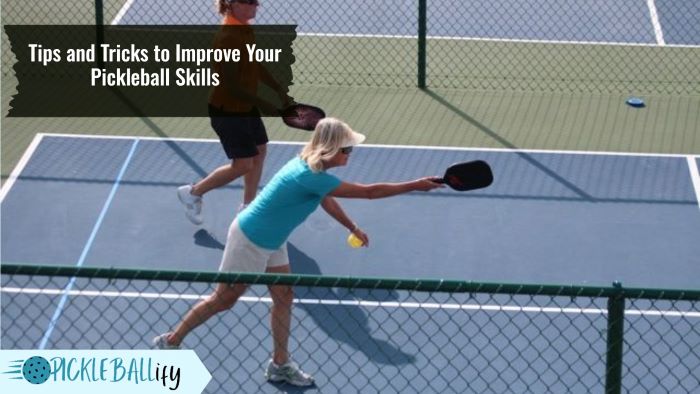
- Use angles and placement: You and your partner can take advantage of angles and free space on the court created by a serve that travels crosscourt or down the line. Also, serving to the middle might make it difficult for your opponents to communicate with one another.
Consider your opponents’ strengths and weaknesses as well as your own game plan while positioning your serve.
- Practice consistency and confidence: You may avoid handing your opponent easy points by consistently serving the ball into play. Your opponents will feel intimidated and will start to admire your abilities if you serve with assurance and without any hesitation or uncertainty.
Develop a routine that works for you and try to practice your serve frequently. Prior to each serve, make an effort to remain composed and concentrated while picturing a successful result.
FAQs
Yes, there are several apps and electronic devices available that can assist with scorekeeping in pickleball. These tools can automate the scoring process, track statistics, and provide real-time updates, making it easier and more convenient to keep track of the score during a game. However, it’s important to remember that using technology should not replace the players’ responsibility to accurately keep score and follow the rules of the game.
Yes, when announcing the score in pickleball, the serving team’s score is typically stated first, followed by the receiving team’s score, and then the server’s number (1 or 2). For example, “3-2-1” would indicate the serving team has three points, the receiving team has two points, and the server is in the first position.
Before the start of each new serve in pickleball, the score should be announced. This keeps everyone on the team, including rivals and spectators, aware of the score and prevents misunderstanding. To make sure everyone is aware of the score, it must be announced clearly and loudly.
Pickleball games that end in a 10-10 draw are sometimes referred to as “win by 2” situations. Up until one side holds a lead of at least two points, play continues. If the score is tied at 10 points each, for instance, the game will continue until one side scores 12 points or more and has a lead of two points over the other team to win.
Well, It’s a Wrap
In conclusion, keeping score in pickleball is an essential aspect of the game that ensures fair play and helps players stay informed about the progress of the match. By understanding the basic scoring rules, avoiding common mistakes, and communicating effectively, players can accurately keep score and prevent any disputes or conflicts during the game.
Additionally, players can utilize technology or collaborate with both teams to keep score, depending on the level of play and availability of resources. So, whether you’re a beginner or an experienced pickleball player, mastering the art of keeping score is crucial for enjoying a competitive and fun game!

